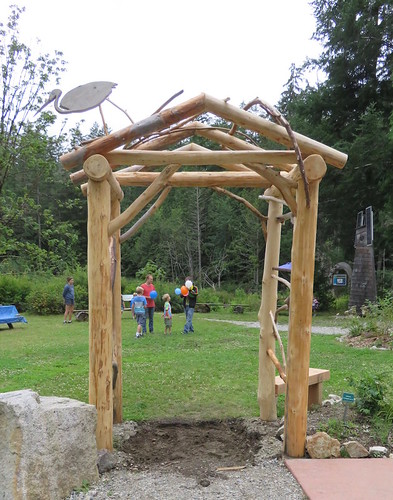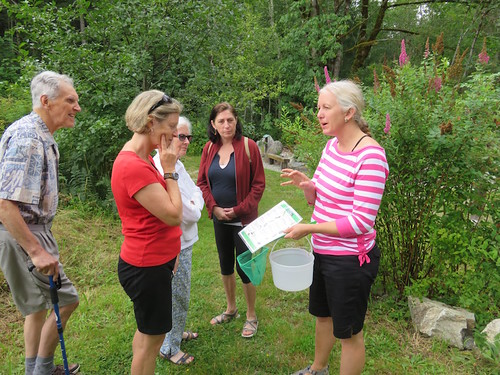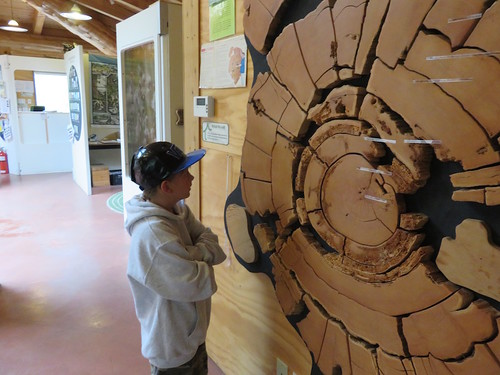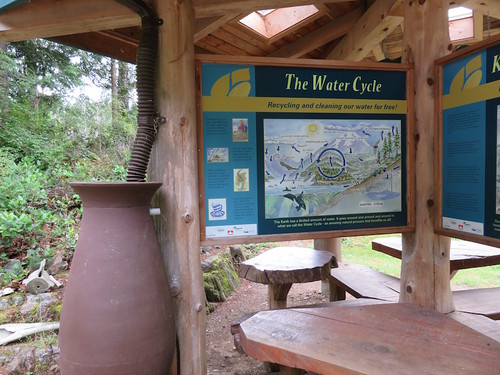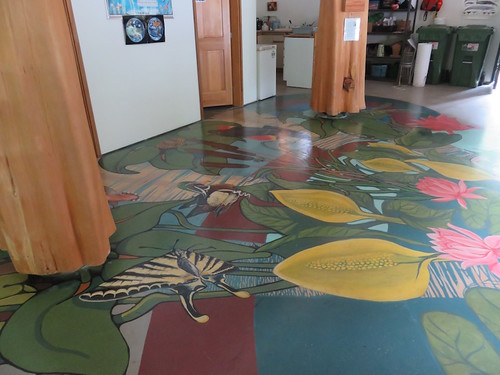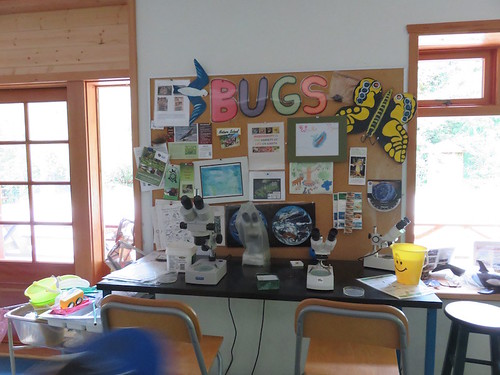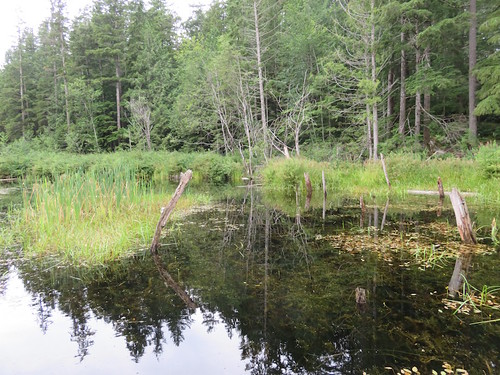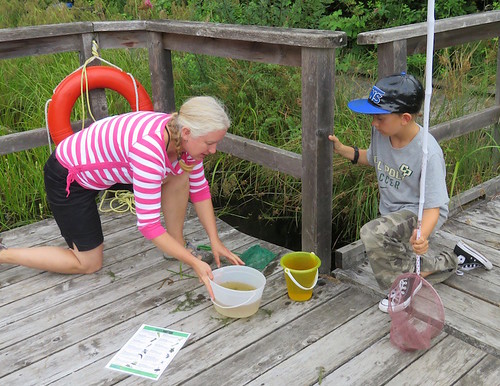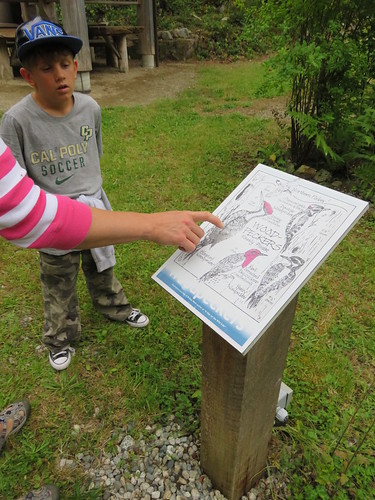Crossing the Inlet
[Published here July 2017 pp. 9-10]
It was only the reduced ferry service leaving two hours to kill before the departure from Earl’s Cove that finally convinced me to pull off the main road and take the driveway marked by the sign: “Iris Griffith Nature Centre.” I had passed it many times on our annual road trip from California to Lund, intrigued by what I imagined was a little old lady’s back yard with labels identifying plants. But that was never enough to get me to delay entering the final stretch of the three-day drive to our home away from home at the end of the road. This time, alone with our nine-year old grandson, Lucas, I decided to satisfy my curiosity.
The gravel track through the forest opened to a large clearing. Through an artfully designed gateway I saw a bunch of kids engaged in some kind of race on a groomed lawn, egged on by college age counselors.
Behind the lawn lay a wetland marsh and a small lake. In the background rose the vertical green wall of Mount Hallowell whose top disappeared in the clouds.
It took me a while to take in the features of a massive log building fronting the lawn: its posts and beams of flared cedar trunks, its large windows filled with displays of books and posters, its roof topped with an array of solar panels.
On the way toward the entrance doors I noticed a white haired woman in a bright pink and white top holding a bucket and pointing out items on a laminated chart to a group of older visitors.
Once inside we were surrounded by a spacious arrangement of displays about the natural history of the BC coastal ecology I had treasured since living here full time in the 1970’s. The displays were illuminated by a skylight in the central atrium supported by bright mortised log beams.
Still stunned by this splendor in the middle of the forest, we were approached by the lady in pink. She introduced herself as Lee Ann and led us to a reconstructed cross-section of the trunk of a tree with the tightest rings I’d ever seen. “How old do you think this is, she asked Lucas, ” and he ventured, “Two hundred?” “No it’s two thousand,” she replied. “This is from a yellow cedar cut at the top of the mountain out back.”
I expressed my wonder at discovering this place after so many years of ignoring it, and she offered to show us around. Passing engaging posters explaining their solar and wind energy and rainwater collectors she took us to the laboratory-classroom downstairs.
There she gave us nets, buckets and charts and led us out to a floating platform at the edge of the wetland, which she told us, had originally been created by beavers, then drained and farmed by earlier settlers, and recently restored as wildlife habitat.
She showed Lucas how to scoop up little critters, identify and study them with the help of the charts, and then add them to the aquariums in the lab. With a couple of passes he found water boatmen, a dragonfly nymph, a water scorpion and a leech. In this surrounding, even a leech was a precious find.
Lee Ann had to leave and welcome other visitors”it turns out she was the place’s Director”but invited us to keep collecting and looking around. We took the specimens back to the lab and then wandered along a trail behind the lake where Lucas discovered a big hole in a tree at eye level. Near the end of the trail a sign portrayed a similar hole and the pileated woodpecker that made it.
Back at the Centre we met Lee Ann again, and I plied her with questions. What’s the history of this place? Is it open all year round? How can it thrive so far from even the small towns of Pender Harbor? How is it financed?
She told me that it’s been in existence since 2005, run by a non-profit organization called the Lagoon Society. They are now well funded by private and government grants, but much of the artwork, the displays, and the design and construction is by local Sunshine Coast resident volunteers. Their mission is to learn and teach about nature and promote sustainable lifestyles and technologies that work with rather than against local natural systems. They run weeklong educational programs for the Sunshine Coast school system all year, and they’ve recently purchased a bus to provide transportation to and from the Centre.
I mentioned that my wife and I had run a summer day camp for children near Lund with similar objectives but on a tiny scale compared to this. I knew that the kind of environmental education they were providing was of great interest to people across Jervis Inlet in Powell River and asked if they had much communication with folks over there. She said no, there had been little connection, but they would be happy to use their bus to pick up people at the ferry and bring them to the Centre for all kinds of programs.
When I mentioned that I now work with a non-profit organization in California promoting sustainable agriculture at small local farms and educational programs for school children, she said their organization’s Executive Director had just arrived and asked if I’d like to meet him. She disappeared for a moment and returned with a jolly curly red-haired man named Michael Jackson.
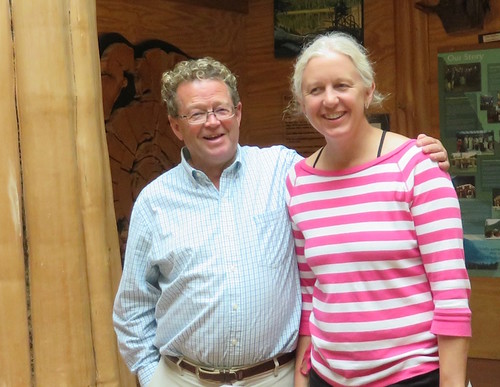 In response to my enthusiasm about this facility, he said that they were now engaged in a much larger project. The place-based mission they began with over ten years ago””To preserve and enhance the natural habitat and wildlife of the Ruby Lake Lagoon, to facilitate local environmental education, and to assist in monitoring the ecological health of the Sunshine Coast””has expanded to the “Sunshine Coast Biodiversity Strategy””which “provides a coast-wide assessment of the many challenges we face in preserving and enhancing the biodiversity of our region and shows how we can begin to address the deficiencies.” One element of this strategy is to build a facility in Pender Harbor that will be a local aquarium and major teaching and research facility to be completed by 2020. They are well on their way to raising the $10 million needed to bring it to completion.
In response to my enthusiasm about this facility, he said that they were now engaged in a much larger project. The place-based mission they began with over ten years ago””To preserve and enhance the natural habitat and wildlife of the Ruby Lake Lagoon, to facilitate local environmental education, and to assist in monitoring the ecological health of the Sunshine Coast””has expanded to the “Sunshine Coast Biodiversity Strategy””which “provides a coast-wide assessment of the many challenges we face in preserving and enhancing the biodiversity of our region and shows how we can begin to address the deficiencies.” One element of this strategy is to build a facility in Pender Harbor that will be a local aquarium and major teaching and research facility to be completed by 2020. They are well on their way to raising the $10 million needed to bring it to completion.
As we left I asked myself whether here at Ruby Lake, out on the furthest margin of the Sechelt Peninsula, it’s plausible that such a grand and transformative vision could be realized. Well, who would have believed in 1970 when we came to the Powell River area as back“to-the-land hippies and when the economic, social, and cultural underpinning of the community was the largest pulp and paper mill in the world, that today the area has become a center of artistic, humanitarian, and environmental innovation as well as of hiking and biking opportunities that draws people from the ends of the earth.
It seems like a good time for the mental gulf between Saltery Bay and Earl’s Cove to be bridged. People on each side need to know more of what the other has to offer and to join forces in their efforts to make the changes that the great world outside is still slow to adopt. One way is for travelers on their way to the ferry and curious about the sign saying Iris Griffith Nature Centre to turn down that road.
For more information: http://www.lagoonsociety.com/who-we-are/iris-griffith-centre/


